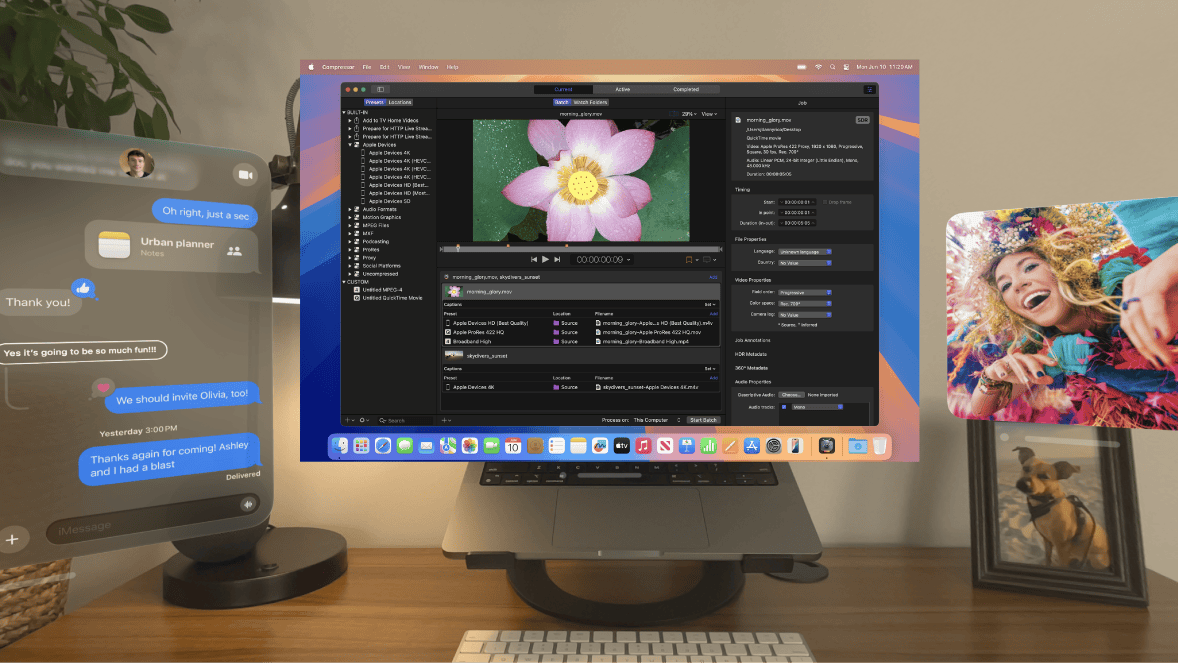Apple has unveiled the first beta of visionOS 2.2, bringing exciting updates to the Mac Virtual Display feature for Vision Pro users with new “Wide” and “Ultrawide” modes.

Apple Vision Pro Expands its View: visionOS 2.2 Beta Introduces Wide and Ultrawide Display Modes
Apple is giving developers even more flexibility with the Apple Vision Pro headset. The latest visionOS 2.2 beta introduces exciting new display modes: Wide and Ultrawide. These modes change how the Vision Pro displays content, making it feel like you have a massive screen in front of you.
Wide Display Mode
Wide mode expands your virtual screen’s field of view. It’s like having a giant curved monitor that wraps around your vision. This mode is perfect for immersive experiences like watching movies or playing games.
Ultrawide Display Mode
Ultrawide mode takes it a step further, giving you an even wider field of view. Imagine having a panoramic screen that fills your peripheral vision. This mode is ideal for tasks that require a lot of screen real estate, like working with multiple windows or editing panoramic photos.
Developer Tools and Customization
Apple has provided developers with tools to optimize their apps for these new display modes. This means apps can take full advantage of the expanded screen space, providing a more immersive and productive experience.
Enhanced Entertainment and Productivity
With Wide and Ultrawide modes, the Apple Vision Pro becomes an even more versatile device. Whether you’re looking for a cinematic entertainment experience or a more productive workspace, these new modes offer something for everyone.
New Display Modes in visionOS 2.2 Beta
| Mode | Description |
|---|---|
| Wide | Expands the field of view, like a curved monitor. |
| Ultrawide | Provides an even wider field of view, like a panoramic screen. |
As Apple continues to refine visionOS and add new features, the Vision Pro is shaping up to be a truly revolutionary device. With its immersive displays and powerful capabilities, it’s pushing the boundaries of what’s possible in spatial computing.

Short Summary:
- Introduction of “Wide” and “Ultrawide” display settings for the Mac Virtual Display feature on Vision Pro.
- The Ultrawide setting is designed to mimic the experience of two 4K monitors side by side.
- visionOS 2.2 is set for a public release in December, alongside various other system updates.
Today, Apple took a significant step forward by seeding the first beta of visionOS 2.2 specifically for developers. This important update introduces two highly anticipated display modes—”Wide” and “Ultrawide”—for the existing Mac Virtual Display feature on the Apple Vision Pro headset.
Mac Virtual Display allows users to utilize the Vision Pro headset as an external display for Mac computers. Since its inception earlier this year with the launch of visionOS, this feature has attracted considerable attention from developers and tech enthusiasts alike. However, the introduction of the new display options marks a significant enhancement that users have been eagerly awaiting.
According to Apple, the Ultrawide setting provides an experience equivalent to having two physical 4K monitors positioned adjacent to each other on a desk. This means that users can enjoy an expanded workspace without the need for additional hardware. The new Mac Virtual Display modes now include three sizes: Normal, Wide, and Ultrawide.
“The Ultrawide display is a game changer for productivity, offering a seamless and immersive experience for Mac users,” said an Apple spokesperson.
For users eager to take advantage of these new settings, it’s essential to have both the visionOS 2.2 beta installed on the Vision Pro headset and the latest macOS Sequoia 15.2 beta installed on the Mac. This integration is crucial for the functionality of the Mac Virtual Display’s expanded capabilities.
The latest beta also boasts improvements in audio playback, which now emanates directly from the Vision Pro headset rather than the connected Mac. Additionally, general display quality has seen a notable enhancement, achieving higher resolutions, fulfilling the promises made by Apple during the WWDC event earlier this year.
What’s New in visionOS 2.2 Beta
- Three display sizes: Normal, Wide, Ultrawide.
- Enhanced display resolution for a more immersive user experience.
- Audio playback functionality shifted to Apple Vision Pro headset.
- Easy management of the display modes with a new floating button interface.
Furthermore, the user interface for toggling between the display modes has been upgraded. A floating button located above the window now allows users to conveniently switch between Normal, Wide, and Ultrawide settings with ease. This intuitive addition enhances the overall user experience, making it simpler to adapt to various tasks and workflows.
As is customary with Apple, the public release of visionOS 2.2 is expected in December, coinciding with other significant updates, including iOS 18.2, iPadOS 18.2, macOS Sequoia 15.2, watchOS 11.2, and tvOS 18.2. The development community remains engaged, looking forward to exploring further potential improvements with these updates.
“This beta version showcases Apple’s continual commitment to enhancing user experience through innovative features and functionalities,” noted an industry analyst.
In conclusion, the introduction of the “Wide” and “Ultrawide” modes in visionOS 2.2 signifies a noteworthy evolution of the Mac Virtual Display feature for Vision Pro users. With the promise of expanded workspaces and enhanced audio-visual quality, this update aims to transform how users interact with their Macs through augmented reality. While the public awaits the official release, developers already have the opportunity to explore these new features and contribute to a more seamless integration of technology and user experience.
Additional Features of Apple Vision Pro
The Vision Pro headset, like all of Apple’s products, prioritizes accessibility. It comes with a variety of inclusive features such as Live Captions for real-time transcriptions of speech and audio, an option for Smart Color Inversion, and support for Cochlear Implants. This design philosophy showcases Apple’s commitment to meeting the needs of all users.
As the tech world looks forward to the capabilities that the combination of the Vision Pro and Mac Virtual Display will offer, the emphasis on productivity and accessibility positions Apple at the forefront of augmented reality innovation.
In the meantime, users are encouraged to explore the beta version and provide feedback to help refine these exciting new features before the public rollout.







